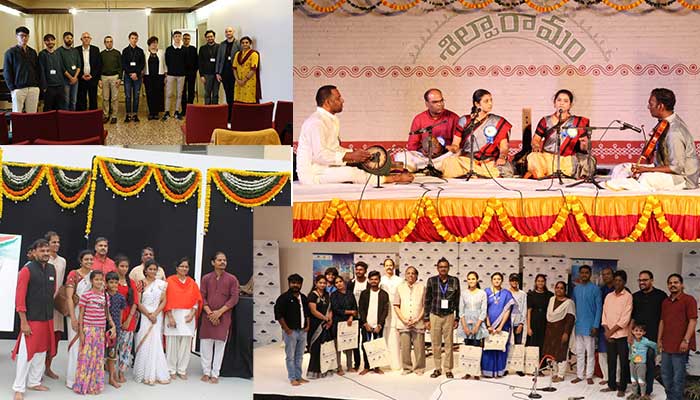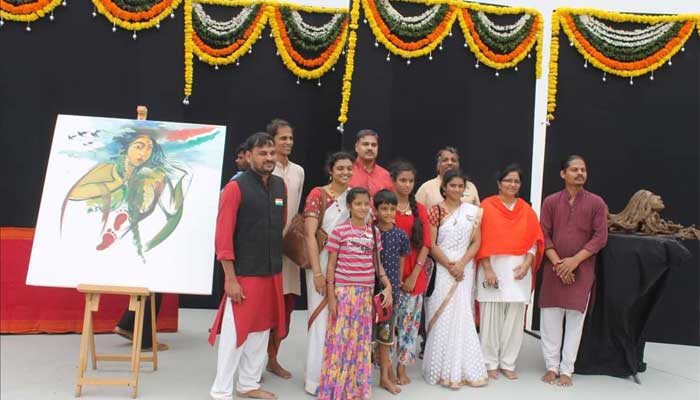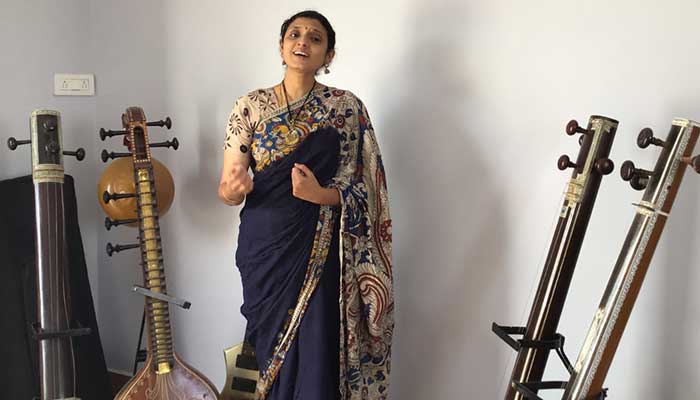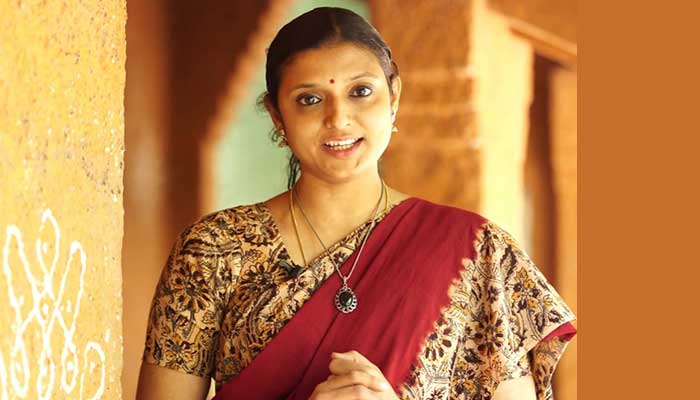Renowned Carnatic vocalist T K Saroja and the team at IIITH’s Center for Exact Humanities are looking into Music and the Arts as a catalyst for improved mathematical prowess and to aggrandize imaginative skills. We learn more.
Dr. T K Saroja, the older sibling of the renowned Carnatic vocalist duo TK Sisters is researching on how classical Ragas can sharpen focus, discipline , logic and mathematical ability. Her research interests are in Indian classical music of South India. Mentored by the out-of-the-box thinking style of the Late. Prof. Navjyoti Singh, who believed that humanities as a knowledge system intersected closely with the sciences, his hand-picked team at CEH would explore the confluence of art, science and technology.
“Raga and Rhythm is a course that I designed to introduce the basic principles of music, teach its finer aspects and help students understand the benefits of Art as a system of knowledge. I believe that entertainment is an additional quality of Art, which primarily is a hub of creative ideas that helps nurture powers of invention”, she observes. At the CEH, a typical day would involve delving into different aspects of Raga study, prepping students for concert practice and researching on music belonging to different genres.
Saroja points out that “students are very comfortable with learning music and start enjoying themselves once they realize that beyond entertainment, it is easily relatable to life, emotions, values, creativity and helps them break their inhibitions. A few years back, I arranged for some of my students to sing for Telugu TV serials”. Several of her students continue to choose this elective in their 3rd or 4th year and participate in music events within and outside IIITH.
Shock, Awe and Raga Navjyoti
It was marriage to Janardhan, a voice artist and media professional that brought Saroja to Hyderabad, and a newspaper ad for music lectureship that would bring her as faculty at CEH.
“The first thing that Prof. Navjyoti did when I joined was to hand me the results of a project, 37 pages containing thousands of phrases in various combinations of Saregama”. She was tasked to evaluate the scope for the phrases to be constructed into a Raaga. “I didn’t have a clue about what he was talking about. To my dismay, he wanted me to present it next day to his colleagues. I thought he was joking but he was dead serious. He said, Take your time. There are many hours between now and 10 AM tomorrow!” comments the singer-composer-music producer.
Flipping through the pages, on the long cab ride back to her residence, she realized that the phrases were part of many known ragas like Kalyani or Vachaspati. “My attention zeroed in on one particular phrase and as I worked on its structure, a significant shruti or raga emerged. It was an exciting moment. Once I got home, I started elaborating, setting the swaram, the Ārōhanam (ascending scale) and Avarōhanam (descending scale) of the rāgam. I added random popular lyrics and it started sounding really good. Then I composed a proper varnam in that raga which was acknowledged by many senior musicians when Prof. Navjyoti played it for them”. She named the Raga – Navjyoti after her mentor and Project Raga Dhyana thus had an auspicious beginning. ‘
“It was then that I understood what he meant when he said that working under healthy pressure gives wonderful results! From my teenage years, I have been composing music and performing but never ever thought that one day, I would be doing something so academically oriented. I give 100% credit to the Institute and to the guidance of Prof. Navjyoti Singh for my academic research activity”, she remarks.
How a student rejigged the existing Melakarta system
The Carnatic vocalist’s collaboration with students would result in some noteworthy papers. Based on Prof. Navjyoti’s recommendation, Saroja designed two courses that threw up some interesting questions. With her mentoring, her student Jayganesh who was dissatisfied with the existing raga classification system would deep dive into the subject and would come up with interesting variations.
Historically, several systems of raga classification did not follow any logic. Venkatamakhi, a musicologist proposed the 72 Melakarta system and any associated Raga would be regarded as its offspring and thus with absolute logic, he established a parent-child relationship. Her student designed a simple mathematical formula that expanded the idea of a parent from 72 to 2,048, addressing many issues and redefining the idea of parent. “That was the first time that I had published a paper (Raga classification in Carnatic Music Revisited) at an international conference”, she smiles.
Another student Harita, would write a paper on the association between Swara and animal-bird calls, that had references in the Shastras. Like Shadja or Sa is associated to the peacock call or Re to the bull, every swara has a corresponding animal/ bird sound and their investigation threw up some very fruitful insights.
Music in her genes
“I come from several generations of musicians, with both parents being self-trained singers and my grandfather who was a great Carnatic exponent”, observes Saroja. “Our parents Dr.T.K. Chudamani and Sri TKLN Acharyulu recognized our talent at a very young age and encouraged my sister Sujatha and me to learn music”. It was in her seventh grade, that the TK Sisters would come under the guidance of Sangitha Sahitya Kalanidhi Sriman. N.Ch. Krishnamacharyulu, a renowned multi-faceted musician and litterateur on the Carnatic music landscape in Vijayawada. “Whatever I have achieved in music, I attribute to my Guru who taught us the technical aspects of grammar and language and a systematic approach to music”.
After her schooling at Vijayawada’s Railway school and B.A Mathematics from Sharada Degree College, Saroja would complete two Masters programs; Carnatic music from the University of Madras and Mathematics from Acharya Nagarjuna university. Concurrently with private music classes, she pursued a distance Ph.D program from Sri Padmavathi Mahila Viswa Vidyalayam, Tirupathi.

I go where the Music takes me
“We had a wonderful childhood and our travels with our parents were always musical and cultural journeys” says Saroja whose mother gave upanyasams/ lectures on various spiritual aspects of Ramayana, Bhagavatam etc. “For almost 25 days in a month, after school, we would either attend a concert, kavisammelan, our mother’s discourses, Ashtavadhanam or something from the cultural space”. They participated in scores of competitions at school and college level, winning prizes in everything from group singing to elocution and essay writing.
As the TK Sisters, the musical duo have had recitals in cities across Andhra, Telangana, Tamil Nadu, Karnataka and in the USA. “We have been studying Hindustani music from Pt. Satish Kashikar. The next thing on my wish list is to learn Sanskrit because it is a highly systematic language” says the vocalist who is guest faculty for the University of Silicon Andhra, an online university in California.

Saroja has been a music composer with All India Radio and as part of Ee Maasaku Paata, has composed, taught vocalists and recorded 15 songs for the regional channel. The vocalist-composer has brought out many musical albums like Tyagarajam bhaje, Namo Namo Maruthi, Laxmi Narasimham, Veerabhadra Suprabhatam and Jai Ramanuja as well as composed music for dance dramas on religious themes like the Vishnu Sahasranamam, Mahalakshmi Vaibhavam and Amuktamalyada, scripted by her mother.
Saroja’s husband Janardhan is a voiceover and mimic artist for movies, serials, documentaries, advertisements. Their children; Suswara and twins-Vaishnav and Madhurima are equally passionate about music and playing instruments. “We have tried to give our children the kind of exposure to music, dance and theatre performances that we had, growing up”, says the purist who has now started appreciating other genres like film and western music, thanks to her husband and children.
Raaga as food for the technical soul
“When I talk about music and self-discipline to students, I draw examples from musical verses. It makes me happy when they tell me that these beautiful messages from songs stays with them and is bringing subtle changes in their perspective on life”.
Saroja plays a key role in curating musical performances within IIITH for academic occasions and inter-collegiate events. Samvada, a tableau centred around a principal theme brought together the art forms of music, dance, sculpture and painting, while the dance ballet Sandhi – the romance of syllables, was based on language for an LTRC workshop.

“Prof. Navjyoti often cited Gottfried Leibniz’s theory of Monadology to demonstrate how someone who gave us integral calculus could expound on philosophy”. She points out that there are scientists who are painters and musicians. Ideas are the route for innovation in life and can germinate from any field, particularly art, that helps one think more creatively and tangentially.
“In the early days, Prof. Navjyoti’s department felt like the Court of King Bhoja where arts, sciences and literature flourished. All of us in music, dance, painting, sculpture and theater would have a weekly performance. IIITH is a happening place that always aspires to accommodate diversity and I learn and enjoy various good experiences on campus every day. The cultural ambience has a freshness and encouraging feel. My big aim is to work on music and health, which is a huge endeavor. On the practical side, I want to see how Indian music can connect to world systems of music”.
The maestro believes that constant engagement with Art is a good tool to inculcate self-discipline through Sadhana and helps to improve overall personality. “Art will teach you everything that is required to lead a good life”, she believes.




Next post